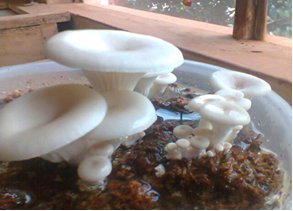
Mushroom production has been described as the most versatile and prolific agricultural venture all over the world. Following China’s government intervention by providing research institutions with fund for capacity building and dissemination, China now produces 5 million metric tons of mushrooms valued at $20 billion. It also provides employment for over 30 million people. This was a dramatic upsurge from the 60,000 metric tons before the 1978 reform in that country. Also, in 1975 in Pennsylvania, USA (known as ‘mushroom capital of the world) it gave employment to over 10,000 people producing mushroom valued at $63.8 million. The total world production of mushroom in 1997 amounted to 7 million metric tons valued at $30 billion, a phenomenal rise from the 350 metric tons produced in 1965.
Mushrooms grow easily in tropical rain forest ecology but Nigeria especially the south east still relies on the wild varieties some of which are poisonous and this limit its consumption. The duration of the collection and quantity collected are also limited by climate change but artificial production of mushroom can take care of problems associated with climate.. A leeway is homestead mushroom cultivation. A number of alternative substrates can be used to grow the mushroom as a homestead crop. Oyster mushroom has about 61 percent protein, scarcely no fat and a lot of minerals and vitamins; it has the highest content of vitamins B1 and B2 than all other mushrooms; it contains 5 to 10 times the amount of niacin than any other vegetable and that is a very vital vitamin. Mushroom can help reduce malnutrition especially among children. Mushroom cultivation does not require much land.
Steps for growing edible mushroom using low cost housing and artificial substrate
• Low cost housing for artificial mushroom cultivation, ventilation requirements and improvising of dark room equipment: a small hut roofed with local mat or thatch/grasses (‘izza’), netted with wire gauze, wooden cardboard and black cellophane.
• Making a substrate: Many agricultural by-products/wastes such as rice bran, maize straw (leaves), shredded cobs, saw dust, banana leaves, cotton seed hull, wheat straw and palm kernel cake or palm fibbers are used to make mushroom substrate. Water is used to moisten the mixture selected and turned. Nitrogen supplements and gypsum can be added to enrich the substrate mixture and thoroughly mixed in a mixer (use maize cob, saw dust, palm kernel cake and lime in the ratio of 5:3:2:1) or cotton seed hull and sawdust or cotton seed hull and maize straw. Put small parts of the mixture in colorless cellophane, you may allow it to ferment for about 2 weeks. Or a ratio of 7:2:1 of maize cob, sow dust and lime
• Sterilization: use big pot or drum, use big stones to prepare tripod stand, place drum or pot on it, put small tripod stand in the pot, add enough water, use hard material to suspend the material in cellophane on the small tripod stand, heat the pot such that only steam touch the material in cellophane for 6-8 hours, after 2 days put the substrate in plastic containers and compress, then spawn (inoculate).
• Spawning: This is the process of introducing the spawn on prepared medium for growth. It can be by broadcasting over the surface of the substrate in containers which are firmed by compacting. This compacting helps to reduce the air in the substrate and enable incubation of the spawn.
• Spawn Maintenance: The desired mycelial culture should be pure and free from contaminants. Contaminants include dirty water, other fungi, bacteria, or insects growing on or infesting the culture media along with the desired mycelial culture. Spawn must be procured from reliable sources such as research institutes avoid open market trading on spawn. Storage is usually by refrigeration.
• Spawn production procedure: Small pieces of pure-culture mycelium are placed in small batches on the choice grain- wheat, ‘Cajenus cajan’, millet or sorghum. The choice grain is prepared by soaking for 2 days, air drying for about 24-29 hours and autoclave for 24 hours along with the small container with cover for storing the spawn. Put the spawn into the container and cover it. once the small batch is fully colonized, it is used to inoculate several larger batches/portions of grain. This multiplying of the inoculated grain continues until the commercial-size containers—usually plastic bags with breathable filter patches—are inoculated. During the colonization of each batch, the containers are shaken every few days to distribute actively growing mycelia around the bag or bottle. During the process, temperatures are maintained at 74 ºF –76ºF (23 ºC –24ºC).
• Casing to trigger reproductive stage: Casing is the method of forcing mushroom mycelia to change from the vegetative phase to a reproductive state. This can be achieved by applying a cover of a suitable material on the mycelia growth.
• In watering or irrigation care must be exercised to avoid water logging the substrate it is also advicable to water the substrates immediately after each harvest. In watering don’t allow water to touch the mushroom to avoid rotten..
• Monitoring the Pinning processes to harvesting: Mushroom rhizomorph grows and expand into structures called primordial or pins. The pins grow larger through a prebutton stage and enlarge to mature mushrooms. Harvesting begins 17–24 days after casing, which is normally 15–20 days after flushing and 8–9 weeks after broadcasting.
• Harvesting and sorting: Mushrooms are harvested over a 2–3 or 4- day. The harvested mushroom is kept in cartons or baskets. They are sorted according to sizes and weighed for sale.
Cost and returns of a low cost mushroom production enterprise
Cost items Amount Total
Housing (8 by 6 meters) 150,000.00
Equipment 80,000.00
Estimated working cost 50,000.00
Total investment cost estimated 280,000.00
PROFITABILITY
Revenue from sale of 4000kg @ ₦150.00 600,000.00
Sales of used substrate as manure 4,000.00
Total income 604,000.00
Gross margin 554,000.00
Annual net profit (straight line depreciation with zero salvage value for 4 years)
496,500.00
























